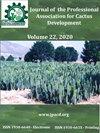Effect of cactus pear mucilage as a moistening additive for corn grain silage
IF 0.4
4区 农林科学
Q4 HORTICULTURE
Journal of the Professional Association for Cactus Development
Pub Date : 2023-11-06
DOI:10.56890/jpacd.v25i.515
引用次数: 0
Abstract
The purpose of this study was to evaluate the effects of different proportions of cactus pear mucilage as a moistening additive on chemical composition, ammonia nitrogen, volatile fatty acids, microbial dynamics, fermentation losses, pH, and aerobic stability of corn grains in the form of silage throughout storage periods. The study was carried out in a completely randomized design with a factorial arrangement (5×2), with four replications. The factors corresponded to five forms of moistening for corn grain silage, 0, 5, 10, 20, and 40% of cactus pear mucilage (MA) associated or not with urea (U) in the level of 1.5% of DM. The lowest DM content was found in the silage moistened with 40% of cactus pear mucilage, and the greatest CP content was found in the same treatment but when urea was added. Lower contents of propionic and butyric acids were observed in the silages moistened with 5 and 10% of cactus pear without and with the addition of urea. Dry matter recovery was higher in the treatments with water and 10% of cactus pear. The use of urea affected the LAB population only at 15 d of silo opening, providing a bigger population (6.58 logs CFU g-1) when compared to silages without urea (6.27 logs CFU g-1). The lower concentrations of propionic and butyric acids observed in the silage moistened with 5 and 10% of cactus pear mucilage, regardless of the addition of urea. However, it is recommended to use 10% of cactus pear mucilage without the addition of urea, as it provides better indicators of good-quality silage.仙人掌梨粘液作为玉米青贮润湿添加剂的效果
本研究旨在评价不同比例的仙人掌梨粘液作为润湿添加剂对青贮玉米籽粒化学成分、氨氮、挥发性脂肪酸、微生物动力学、发酵损失、pH值和好氧稳定性的影响。该研究采用完全随机设计,采用因子排列(5×2),共4个重复。在DM水平为1.5%的情况下,玉米青贮0、5、10、20和40%仙人掌梨粘液(MA)与尿素(U)不相关的5种湿润方式对应的因子为:40%仙人掌梨粘液(MA)湿润的青贮DM含量最低,相同处理但添加尿素的青贮CP含量最高。在不添加尿素和添加尿素的情况下,用5%和10%的仙人掌梨湿润青贮的丙酸和丁酸含量较低。水处理和10%仙人掌梨处理的干物质回收率较高。尿素的使用仅在开仓15 d时影响乳化酶种群数量,与不添加尿素的青贮(6.27 log CFU -1)相比,乳化酶种群数量(6.58 log CFU -1)更大。与尿素添加量无关,添加5%和10%仙人掌梨粘液的青贮饲料中丙酸和丁酸浓度均较低。但建议在不添加尿素的情况下使用10%的仙人掌梨粘液,其青贮品质指标较好。
本文章由计算机程序翻译,如有差异,请以英文原文为准。
求助全文
约1分钟内获得全文
求助全文
来源期刊

Journal of the Professional Association for Cactus Development
Agricultural and Biological Sciences-Plant Science
CiteScore
1.10
自引率
33.30%
发文量
10
期刊介绍:
The editors of the Journal of the Professional Association for Cactus Development, are very excited to be a part of the excellent editorial committee and to work together to create the synergism between scientists, growers, legislators, and business people so vital to the development of this industry to serve the people of arid lands.
 求助内容:
求助内容: 应助结果提醒方式:
应助结果提醒方式:


